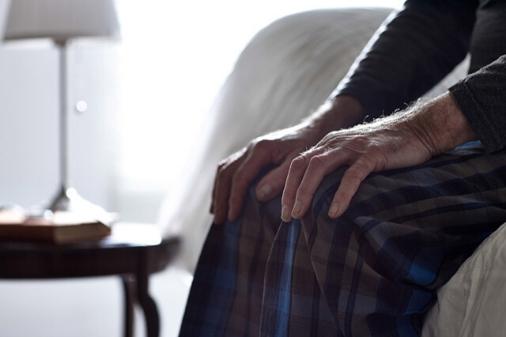Knowing the risk factors and what symptoms you need to watch out for is only half the battle when it comes to peripheral artery disease (PAD). Around 50% of patients diagnosed with PAD did not experience any symptoms in its early stages. This is why we stress early intervention because it could quite literally save both your limb and your life.
Severe PAD can lead to sores or ulcers developing on the toes, feet and legs that may take a long time to heal, which raises the risk for permanent tissue damage and even amputation. The longer PAD goes undiagnosed and untreated, the more life-threatening it can become, increasing your risk for heart attack and stroke.
How Is PAD Diagnosed?
When you come in for your exam, your doctor will initially check the pulse in your feet and perform a non-invasive test called an ankle-brachial pressure index (ABI). An ABI is used to compare the blood pressure in your arms with the blood pressure in your ankles. A low ankle-brachial index number can indicate narrowing or blockage of the arteries in your legs.
Based on test results, you may undergo an arterial doppler ultrasound, which is a test that uses high-frequency sound waves to measure the amount of blood flow through your arteries and veins.
If further tests are required, a CTA or MRA may be recommended to help identify the extent of narrowing in your arteries due to atherosclerosis.
Asymptomatic vs Symptomatic when Diagnosing PAD

When it comes to diagnosing PAD, Dr. Lam takes into account if you are experiencing any symptoms that may indicate it. The 50% of PAD patients who do not experience the classic symptoms are diagnosed with asymptomatic PAD. However, if you have experienced symptoms of PAD, you are diagnosed with having symptomatic PAD and possibly have one of two conditions: Claudication or Critical Limb Ischemia (CLI).
Claudication is defined by cramping and pain in the leg from exercising. This is caused by lack of blood flow due to the obstructed arteries. Cramping and pain in the leg that subside when at rest is called intermittent claudication. If left untreated, it can develop into CLI where the pain becomes severe and becomes present at all times (even while at rest); limiting your quality of life and ability to be active. CLI can also cause ulcers or sores on your feet to develop.
CLI is associated with an increased risk of major amputation so it is important for you to be aware of the symptoms which include:
- Pain or numbness in the feet
- Shiny, smooth, dry skin of the legs or feet
- Thickening of the toenails
- Absent or diminished pulse in the legs or feet
- Open sores, skin infections or ulcers that will not heal
- Gangrene (dry, black skin) on the legs or feet
AMPUTATION RISK
More than half of the patients who have experienced an amputation lost their limbs due to vascular conditions including PAD and diabetes. For this reason, Dr. Lam created The Limb Salvage Center. With the help of this state-of-the-art facility, we look for options outside of amputation, such as surgical or endovascular revascularization, when symptoms don’t respond to guideline-directed management and therapy (GDMT).
The goal of revascularization is to provide blood flow back into the limb which will help decrease pain caused by the blockage and allow healing of any wounds while preserving limb function. This will help minimize the loss of tissue. If PAD progresses, it could develop into Acute Limb Ischemia (ALI) which is seen as a medical emergency. Patients with ALI must be treated rapidly because the longer the symptoms are present, the lower the chance of limb salvage.
How is PAD Treated?
Lifestyle changes and medication are the two most common treatments for PAD, but when those are not enough, your doctor may recommend surgical intervention. Luckily, today’s technology has allowed these procedures to be minimally invasive in most cases, and therefore, they often do not require a hospital stay or extensive downtime.
When it comes to treating PAD, Dr. Lam has a specific treatment algorithm depending on whether your condition is asymptomatic or symptomatic.
ASYMPTOMATIC PAD
Patients with asymptomatic PAD should receive a comprehensive program of guideline-directed management and therapy (GDMT), which includes a structured exercise and lifestyle modification program, to reduce the likelihood of cardiovascular events, such as stroke or heart attack, as well as improve motor function.

Suggested lifestyle modifications that can help you reduce your risk of PAD worsening include:
- Lowering blood pressure and cholesterol
- Losing weight by healthy eating and exercise
- Stopping smoking
Along with lifestyle modifications, Dr. Lam may also prescribe medications that are customized to individual risk factors, such as diabetes and high blood pressure.
The structured exercise program for GDMT is individualized for your type, frequency, intensity and duration of the exercise. This assures that you are constantly challenged to increase intensity while you exercise, as your affected limb’s functional status improves over time.
There are two types of structured exercise programs for patients with PAD:
Supervised Exercise Program
Dr. Lam will assign you a supervised exercise program that will take place in a hospital or outpatient facility. During the program, your qualified healthcare provider will assist you with sessions of intermittent walking. Your program will be three times a week for a minimum of 12 weeks, with walking intervals of 30-45 minutes including periods of rest. The goal of this treatment program is to progress to these levels over time, so it’s okay if you don’t achieve your target in the early sessions.
Structured Community or Home-Based Exercise Program
The other therapy option Dr. Lam may suggest is a structured community or home-based exercise program which would take place in your own personal setting rather than a clinical setting. During this program, your qualified healthcare provider will assign you an exercise regimen similar to that of the supervised program. The healthcare provider offers counseling to help ensure that you understand how to begin the program, as well as helping you maintain and learn how to increase your walking intensity (increasing speed or distance). Health coaching will also be made available to you in case you need any assistance during the duration of the program.
SYMPTOMATIC PAD
If you show no improved response to GDMT and your claudication becomes lifestyle-limiting, Dr. Lam may recommend revascularization as a treatment option. Lam Vascular & Associates offers laser atherectomy, balloon angioplasty and stent placement procedures that are minimally invasive and safely performed in our outpatient endovascular center using state-of-the-art technology. This allows for a faster recovery and no overnight stay in most cases.
Endovascular revascularization technologies
Angioplasty and Stenting
Modern angioplasty is a procedure in which a thin, flexible tube called a catheter is inserted through an artery and guided to the place where the artery is narrowed. Once the tube reaches the narrowed artery, a small balloon at the end of the tube inflates for a short time. The pressure from the inflated balloon presses the plaque against the wall of the artery to improve blood flow. In most cases, a small, expandable tube called a stent is put in place at the same time. Reclosure of the artery is less likely to occur if a stent is used.
Laser Atherectomy
Laser atherectomy is an FDA-approved, minimally invasive endovascular technique for removing plaque from blood vessels within the body. The procedure uses a catheter that emits high-energy ultraviolet light to unblock the artery. Dr. Lam maneuvers the catheter through the vessel until it reaches the blockage.

